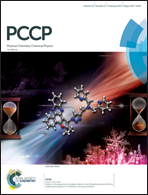Unlocking the electronic genome of halogenobenzenes†
Abstract
The drive to develop new organic materials for use in optoelectronic devices has created the need to understand the fundamental role functionalization plays concerning the electronic properties of conjugated molecules. Here density functional theory (DFT) is used to investigate how the HOMO–LUMO gaps of halogenobenzenes are affected as a function of substituent size, position, electronegativity, ionization potential, and polarizability. A detailed molecular orbital analysis is also provided. It is shown that the molecular static polarizability and ionization potential of the bound halogens are the primary physical descriptors governing the HOMO–LUMO gap within halogenobenzenes. Two secondary descriptors controlling the HOMO–LUMO gap in these materials are the aromaticity of the halogen substituted benzene rings (as monitored via the harmonic oscillator method of aromaticity index [HOMA]) and the reduced population of the halogen atomic orbitals in the frontier MOs (%XHOMO or %XLUMO). The molecular polarizability and aromaticity, as well as %XHOMO and %XLUMO, are shown to be a function of halogen electronegativity and size, as well as number and position on the ring. It is ultimately demonstrated that halogenobenzenes which are most polarizable and are either least aromatic and/or exhibit the smallest %XLUMO (or largest %XHOMO) values, have the smallest HOMO–LUMO gaps.



 Please wait while we load your content...
Please wait while we load your content...